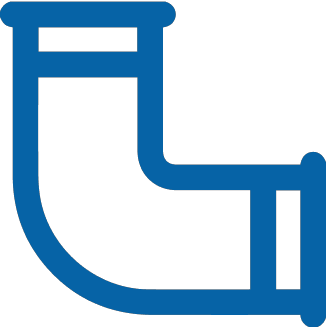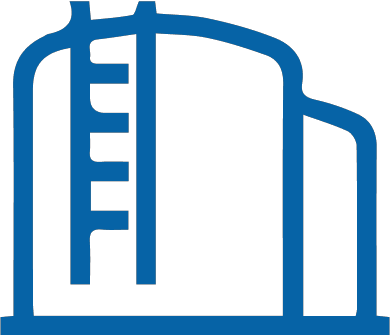HOW AND WHY TO PREPARE SURFACES BEFORE APPLYING PROTECTIVE COATINGS
Protective coatings have become nearly ubiquitous in both our personal and professional lives. They’re used in our homes for everything from garage floor repair to crawl space encapsulation, and have an even larger and still growing number of applications in commercial and industrial environments. Moreover, new and improved technologies are making protective coatings safer, stronger, and more affordable than ever before, realizing exciting new applications like bedliner paint jobs and radar absorbing coatings. However, no technology can replace the critical preparatory work that must be done before any coatings are applied. In the industry, we call this part of the process “substrate preparation,” or surface preparation, where materials are cleaned and modified to have the appropriate surface profile for a given protective coating. Such substrate preparation is essential for creating high-performance and long-lasting coatings systems, and rely on several key preparation techniques. So in today’s blog, we’ll explore how to properly prepare a surface before applying protective coatings, including why surface preparation is so important, several of the most common preparation techniques, and how to choose between them.

WHY IS PROPER SURFACE PREPARATION SO IMPORTANT?
Preparing surfaces prior to application isn’t just a recommendation – it’s a requirement. Most substrates, whether concrete, metal, or otherwise, will possess dirt and debris, along with other potentially detrimental surface characteristics like an unfit texture or an uneven surface. Without taking careful steps to remove contaminants and correct for undesirable surface characteristics, protective coatings may exhibit poor adhesion to the substrate surface, compromising the system’s performance. Additionally, along with promoting quality adhesion, substrate preparation also serves to improve a coating’s aesthetics, extend its lifespan, and reduce the need for maintenance and repairs. There’s no ifs, ands, or buts about it; substrate preparation is central to a high-performance coatings application, and can play just as big a role as the application itself.

3 KEY SURFACE PREPARATION TECHNIQUES
There are myriad different methods and techniques employed for substrate preparation, which depend on the substrate material, coating technology, application environment, operating environment, and many other factors. However, there are several key techniques that find widespread use for a variety of different applications, including three that anyone looking to apply protective coatings should be familiar with: acid etching, grinding, and sandblasting.

ACID ETCHING
Acid etching is a common chemical technique used for preparing concrete surfaces. The process is simple; a strong acid is applied to the concrete surface, which is typically muriatic (hydrochloric) acid or phosphoric acid. The result is the removal of what’s called the “laitance,” or the weak powdery layer made of dust, lime, and sand, as well as any grease, oil, dirt, or other debris. However, while easy and effective, acid etching has more recently come under scrutiny for its questionable efficacy compared to alternative methods, and it’s concerning environmental costs. So while it’s become less popular than it may have been in the past, it remains a common method of preparing concrete surfaces, and is a cornerstone of broader substrate preparation techniques.

GRINDING
Grinding, or mechanical grinding, uses mechanical rather than chemical means to remove the smooth top layer on concrete surfaces. Specialized equipment featuring concrete discs or diamond grinding wheels are forced against the concrete surface to be coated, offering high control over the surface profile, with comparable simplicity to acid etching. Grinding can remove a wide range of different surface contaminants from oil and grease to deep stains or even old protective coatings, while simultaneously modifying the surface to achieve a desired texture, correct for unsuitable surface characteristics, and create the optimal surface profile. It’s a highly versatile and robust surface preparation technique, perfect for small and large projects alike.

abrasive BLASTING
Abrasive blasting is a power surface preparation method that uses a high-speed stream of solid particles such as sand (sand blasting) to clean and roughen a substrate’s surface. This technique can also use other materials like glass beads or aluminum oxide particles, all driven by compressed air. Most often used for metals rather than concrete, abrasive blasting is highly effective at removing rust, old coatings, scale, and many other common contaminants, while also creating a textured profile perfect for applying protective coatings. However, abrasive blasting can also be used for other substrate materials, such as concrete and wood. So whatever the substrate material, abrasive blasting is a powerful and thus widely used method of preparing different surfaces for the application of new protective coatings.

Choosing the Right Surface Preparation Method
Choosing the appropriate method or methods for preparing a substrate before applying protective coatings fundamentally depends on the type of substrate, and its state prior to employing any preparation techniques. For steel, abrasive techniques like sandblasting are recommended, removing all visible rust, mill scale, and other contaminants, and ensuring the surface has the appropriate roughness for robust adhesion. For concrete, both chemical and mechanical methods can be used, including acid etching or grinding, removing all laitance, loose mortar, previous coatings, and any other debris. Additionally, these methods can also serve to adjust the surface profile, again functioning to promote strong adhesion. Other substrate materials may require different or additional techniques, and oftentimes it’s recommended to use multiple methods in parallel to ensure a clean surface with the appropriate characteristics. Similarly, when a substrate has extensive or multiple types of contaminations or unsatisfactory profile characteristics, multiple stronger techniques are also recommended together.

latest news & bLOGS
FREQUENTLY ASKED QUESTIONS
LEARN MORE ABOUT PROTECTIVE
COATINGS WITH ARMORTHANE
Substrate preparation is one important piece of a larger puzzle when applying high-performance protective coatings. If you want to learn more about proper preparatory work, or anything else about protective coatings, ArmorThane offers a wealth of information covering just about any topic you could think of. From choosing the right material, to learning the fascinating science behind protective coatings, our blog series and knowledge center have everything you’d want to know and more. And if all of this information still isn’t enough to quench your thirst for knowledge, we also offer comprehensive start up packages that can help you master the craft and start your own coatings business. With only a small initial investment and no profit-stealing costs or fees, we’ll provide everything you need to learn the ins and outs of applying protective coatings, officiated with ArmorThane certification. Along with personalized on-site training, leading high-pressure spray equipment, high-quality materials, and lifetime support, you’ll be up and running in a matter of no time. So, if you want to learn more about ArmorThane and how we can help you achieve your entrepreneurial goals, contact us today, and see why we’re the best in the business!
CONTACT US
REQUEST A QUOTE
Phone Number
Tel: 417.831.5090
Email Us
moreinfo@armorthane.com
ArmorThane has been a leader in the coatings industry for over 35 years, where we’ve witnessed, and been a part of, polyurea and polyurethane’s explosive rise to prominence. As full-service operators who formulate, manufacture, distribute, and apply our growing portfolio of polyurea and polyurethane products and services, we offer a comprehensive and convenient one-stop shop for all of your coatings needs. Whether you want to find the right formulation for your next concrete coatings project, or discover more about how ArmorThane can help you start your own coatings business, contact us today! Our 24/7 customer service and technical support teams will be ready to answer any questions, and help you get started with confidence.









































